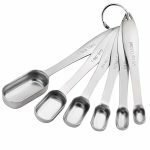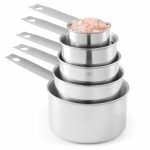This AIP Bibimbap is the ultimate easy one-pan meal. A Korean classic made autoimmune friendly. Plus, make it low FODMAP with one simple sub!
What is Bibimbap?
If you’ve never had bibimbap, you’re seriously missing out! It’s so delicious! Bibimbap (meaning “mixed rice”) is a classic Korean bowl meal. Think of it as a Korean version of a Buddha bowl. It is typically comprised of fluffy white rice topped with a variety of sautéed vegetables, kimchi and a spicy gochujang chili sauce. It is also commonly served with beef and topped with a runny fried egg.
For the purposes of keeping this AIP Bibimbap autoimmune-friendly, I’ve swapped the white rice for cauliflower rice, and swapped the nightshade ingredients (kimchi and gochujang sauce) for a delicious autoimmune-friendly sauce. Though eggs are not part of an AIP elimination diet, if you’ve found that you tolerate eggs, you should definitely add the fried egg on top. It takes this AIP Bibimbap to the next level!
For a low FODMAP version, you can just swap the cauliflower rice back for white rice. See the recipe card for some more low FODMAP additions to this recipe, and be sure to check the Monash University app for the FODMAP content of each ingredient. While this recipe has not been tested for FODMAP content, the basic recipe ingredients are all low FODMAP in their specified quantities. And while coconut aminos have not officially been tested, many people following a low FODMAP diet have not had any problems with them. If you would like to err on the side of caution, though, please swap the coconut aminos for gluten free tamari or soy sauce.
What equipment do I need?
This AIP Bibimbap is a one-pan meal! Who doesn’t love a one-pan meal? I don’t think anyone has ever complained about having too few dishes to clean.
So, for equipment, you’ll just need a medium pan (a 12″ skillet should work great!), some measuring cups and measuring spoons. If you purchase pre-shredded vegetables, the prep work is all but done for you! But if you’re more hands-on, you can shred or julienne your vegetables using a julienne peeler, mandoline, food processor or a good old fashioned box grater.
Sometimes, on the weekend, I just like to turn on some tunes and go crazy shredding a bunch of vegetables. Then I always have them on-hand to toss into stir frys and salads, without having to pay for pre-shredded veggies at the store. #protip
Ingredients for AIP Bibimbap
OK, I realize the ingredients list may look cumbersome, but I promise you this AIP Bibimbap could not be any easier! It’s essentially just six ingredients, a sauce and some optional toppings. Super simple.
First, you’ll need to make the sauce. Just combine these ingredients in a mason jar, seal it and give it a good shake. Done.
- coconut aminos
- freshly grated ginger
- white wine vinegar
- ground turmeric
Then, you’ll need these ingredients for the bowls:
- ground beef
- carrots, grated/julienned
- zucchini, grated/julienned
- purple cabbage, shredded
- green onions, sliced (green parts only for low FODMAP)
- cooked cauliflower rice (for AIP) or white rice (for low FODMAP)
Then, pile on the optional toppings:
- extra sauce
- sesame oil (omit for AIP elimination)
- sesame seeds (omit for AIP elimination)
- sliced fresh green onions (green parts only for low FODMAP)
- fried or poached egg (omit for AIP elimination)
- chopped fresh cilantro
- fermented/pickled vegetables (check FODMAP content if on a low FODMAP diet)

How to make AIP Bibimbap
If using white rice (low FODMAP), combine 1 cup dry white rice with 2 cups water in a medium saucepan. Cover and bring to a boil over high heat. Once boiling, lower the heat to a simmer and cook until water is completely absorbed and rice is tender, about 15-25 minutes. If using cauliflower rice, skip to the next step.
Combine sauce ingredients in a small mason jar and shake well to combine. Set aside.
Heat 1 Tbsp avocado oil in a medium sauté pan. Once oil is shimmering, add ground beef. Stir and break up large pieces until beef is almost cooked through, about 7 minutes. Add sauce and simmer for another minute or two, until sauce is warmed through and beef is fully cooked. Transfer beef to a serving bowl and set aside.
Add a bit more oil, or a splash of water, to the pan (if needed) and sauté carrots until just starting to soften, about 1-2 minutes. Transfer to a small serving bowl and set aside.
Continue in the same fashion for the zucchini, purple cabbage and green onions, sautéing each individually for about 1-2 minutes, and setting aside in serving bowls.
If using cauliflower rice, you can sauté it in the same way, or you can cook it using your preferred method (even just heating in the microwave works!).
To assemble bowls, divide rice/cauliflower rice among four bowls, add cooked beef, carrots, zucchini, purple cabbage and green onions. Then add your favorite toppings and serve!

More recipes
Looking for another easy bowl recipe? Try these Easy Cabbage Roll Bowls or this Nourishing Buddha Bowl. And sign up for the newsletter for more easy, nourishing recipes for those of us who like to eat well on a tight timeline.
Print
The Best AIP Bibimbap (with Low FODMAP Options!)
- Prep Time: 10 minutes
- Cook Time: 20 minutes
- Total Time: 30 minutes
- Yield: 4 servings 1x
- Category: One-Pan Meals
- Method: Sauté
- Cuisine: Korean
- Diet: Gluten Free
Description
This AIP Bibimbap is the ultimate easy one-pan meal. A Korean classic made autoimmune friendly. Plus, make it low FODMAP with one simple sub!
Ingredients
Sauce:
- 1/4 cup coconut aminos
- 4 tsp freshly grated ginger
- 1 Tbsp white wine vinegar
- 1 tsp ground turmeric
Bowls:
- 1 Tbsp avocado oil
- 1 lb ground beef
- 1 cup carrots, grated/julienned
- 1 cup zucchini, grated/julienned
- 2 cups purple cabbage, shredded
- 2 green onions, sliced (green parts only for low FODMAP)
- 2 cups cooked cauliflower rice (for AIP) or white rice (for low FODMAP)
Optional Toppings:
- extra sauce
- sesame oil (omit for AIP elimination)
- sesame seeds (omit for AIP elimination)
- sliced fresh green onions (green parts only for low FODMAP)
- fried or poached egg (omit for AIP elimination)
- chopped fresh cilantro
- fermented/pickled vegetables (check FODMAP content if on a low FODMAP diet)
Instructions
If using white rice, combine 1 cup dry white rice with 2 cups water in a medium saucepan. Cover and bring to a boil over high heat. Once boiling, lower the heat to a simmer and cook until water is completely absorbed and rice is tender, about 15-25 minutes. If using cauliflower rice, skip to the next step.
Combine sauce ingredients in a small mason jar and shake well to combine. Set aside.
Heat 1 Tbsp avocado oil in a medium sauté pan. Once oil is shimmering, add ground beef. Stir and break up large pieces until beef is almost cooked through, about 7 minutes. Add sauce and simmer for another minute or two, until sauce is warmed through and beef is fully cooked. Transfer beef to a serving bowl and set aside.
Add a bit more oil, or a splash of water, to the pan (if needed) and sauté carrots until just starting to soften, about 1-2 minutes. Transfer to a small serving bowl and set aside.
Continue in the same fashion for the zucchini, purple cabbage and green onions, sautéing each individually for about 1-2 minutes, and setting aside in serving bowls.
If using cauliflower rice, you can sauté it in the same way, or you can cook it using your preferred method (even just heating in the microwave works!).
To assemble bowls, divide rice/cauliflower rice among four bowls, add cooked beef, carrots, zucchini, purple cabbage and green onions. Then add your favorite toppings and serve!
Equipment

12″ skillet
Buy Now →


measuring spoons
Buy Now →


measuring cups
Buy Now →Notes
This recipe has not been tested for FODMAP content, but all ingredients are used in amounts compliant with the Monash University App and guidelines.
For the quickest prep, use pre-shredded vegetables. You can also shred/julienne the vegetables yourself with a julienne peeler, mandoline or food processor.
Nutrition information is for AIP version without any additional toppings. All nutrition information is an estimate, only, using an online nutrition calculator.
Nutrition
- Serving Size: 1/4 of recipe
- Calories: 302
- Fat: 10.8g
- Carbohydrates: 12.6g
- Fiber: 3.4g
- Protein: 36.6g
Keywords: bibimbap, bibimbop, korean, bowl meals,








1 Comment
Cathy
November 27, 2022 at 12:12 pmSo delicious! We loved it and I can’t wait to make it again. It was a flavor explosion in my mouth. Very easy to make. No one wanted an egg, so we just made extra sauce and topped with cilantro, green onion, pickled ginger and avocado. Having just finished watching “The Extraordinary Attorney Woo” it was fun to have a Koren dish, even if it wasn’t gimbap.
★★★★★